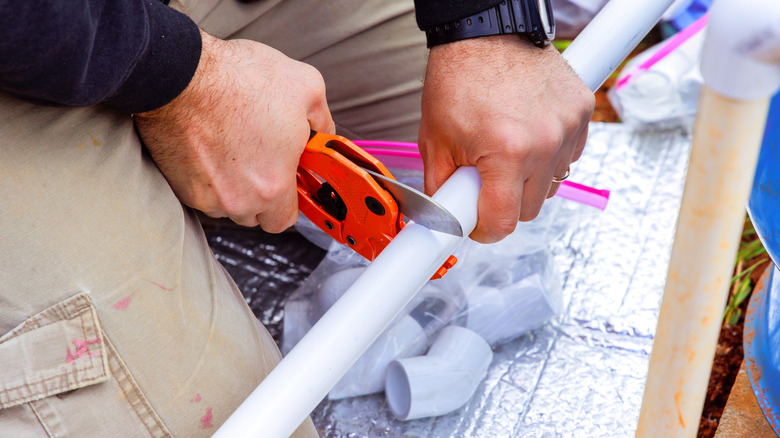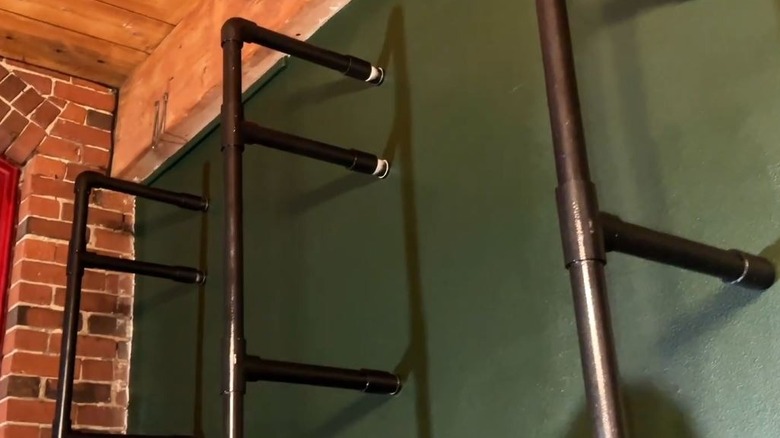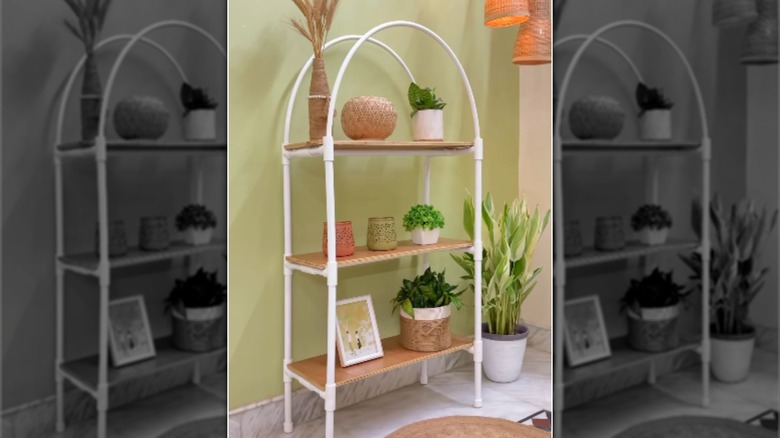DIY Industrial Shelving Out Of Pvc Pipes For A Budget-Friendly Project
Unique shelving units are all the rage, but they usually come with a hefty price tag. If you've been dreaming of a built-in unit but don't have the budget, this innovative DIY will turn PVC pipes into a creative storage shelving unit with a trendy industrial flair. The trick is to use polyvinyl chloride pipes as a cheaper substitute for the steel frames used in similar units for a convincing, budget-friendly dupe.
While steel offers a variety of benefits over plastic for industrial uses, the key to this project is the unit's strength and cost of materials. Steel pipes are about 20% more expensive than their PVC alternatives, so the latter is the clear winner on that front. Of course, metal pipes are going to be stronger than plastic. However, reinforcing this unit with supportive fittings and anchoring it to the wall will make it strong enough to hold whatever you have in mind — within reason!
This idea is a cool, frugal twist on the floor-to-ceiling, built-in storage units that continue to dominate living area design trends. Traditional built-in shelving can cost several thousand dollars —a stark contrast to this project which can deliver a mounted unit large enough to cover an entire wall for under $400. Plus, this DIY can be customized for size and function. Make your unit span the width of your wall, or build a more modest unit using the same basic design. You can add wooden or PVC dividers to your shelves for extra organization, and utilize plastic corners, tees, and other connecting pieces to make this project perfectly fit your space and meet your storage needs.
Prepare and assemble your wall-mounted shelving
You'll need enough PVC pipe to make a frame that spans the full length of the unit, including above the top shelf to connect to the wall and all the way down to the floor, which will connect to floor flanges that serve as the unit's feet. Each shelf will need to be supported by pipes on at least two sides, and those pieces will connect to the main frame by plastic tees. You'll also need a few corner connectors to round off the top of the frame and end caps to connect the whole unit to the wall. It's also a good idea to also get some pipe straps to secure the wooden shelves against the tubes, which will make the entire unit more stable. Don't forget the wooden boards for the shelving, too.
Cut your pipes to size, noting that you'll lose about ¾ inches of length on either side of the tube when it slides into the other pieces. Then, construct your frame, securing all pieces together with PVC cement, which you can find at the hardware store. (Just make sure you get the right product to avoid a common DIY PVC gluing mistake!)
Using fine-grit sandpaper, sand all your pipes and parts before painting them with your desired color. If you want a stainless steel look, Krylon's Metallic Aluminum is a good choice. Finish with a few coats of clear enamel to keep your plastic frame disguised for the long haul. Go ahead and prepare the wooden shelving pieces as well, staining and sealing them to your taste.
How to mount PVC pipes to the wall
Once your frame is assembled, it's time to attach it to the wall. First, take your shelving frame and set it up against the wall, marking where you'll put each connecting point. This is where those end caps come in handy. (This set of FangKingNo PVC end caps should work well and come in a variety of sizes.) Drill a hole through each one, and then use drywall screws to screw them into the wall studs where the frame will connect. Now it's time to slide the frame into the caps. You'll probably need a bit of elbow grease for this part — it might even require gentle hammering to ensure each pipe fits squarely in the end caps. If you want, you can use some more PVC cement to ensure a strong hold.
Once the frame is securely in place, all that's left is to slide in the wooden shelving. Rest each shelf on top of the frame, and screw on the pipe straps around the pipes underneath the shelves, if you're using them for extra stability. If your unit has shelving that extends past the frame, you can anchor them to the wall using L-brackets for some extra support.
There are endless off-the-wall possibilities for pvc storage solutions
If you're a renter, or you just don't want to bother with wall-mounting your project, you can still make a customized PVC shelving unit to add utility and style to your space. Build a free-standing shelving unit to mimic a wall unit and simply place it up against the wall. You could also use the same materials to build complementary accent tables and floating shelves to tie the whole room together. Or, take this basic DIY idea and run with it, creating your own free-standing shelving design for a bookcase, closet shelving solution, or kitchen storage rack. Just keep in mind that without the extra support and stability from the wall, you'll need to be careful about how much weight you put on these plastic storage pieces, but they'll work for most purposes.
PVC has so many great uses around the home, especially when it comes to storage. Get creative using the pipes themselves for fun organization ideas. Create an outdoor towel rack to drape towels over to dry by the pool or hot tub. And don't forget about repurposing any offcuts! They make excellent frugal home storage solutions. Take large polyvinyl chloride pipes and turn them into organizers by cutting them to size and filling them with socks and underwear to organize your closet drawers or make a unique storage solution for your kitchen tools and utensils.


